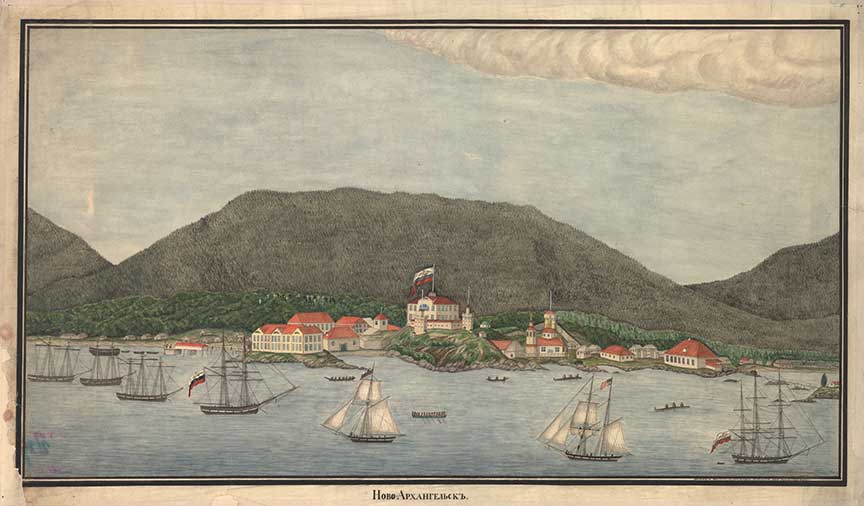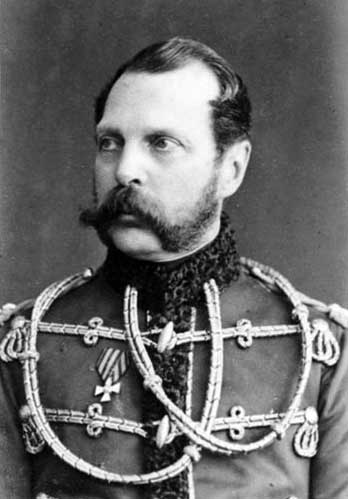Russian American Relations in the 19th Century
by Professor Dmitriy Nikolayev

New Archanagel in 1837
There were different times in the history of American-Russian relations, including the periods of "freezing" and "thawing," mutual admiration and denunciation of each other's vices, cooperation and enmity. Such attitudes changed several times not only in the twentieth century, but also in the nineteenth century. Those relationships which changed from friendly to negative will be shown in this article.
Diplomatic relations between Russia and the United States were established in 1807. But back in 1780, Catherine the Great announced “Declaration of Armed Neutrality”. Russia decided to protect the right of any neutral vessels to travel to Russian ports. That was the time when the young American state fought the war for its independence. The British Empire tried to block its trade and thus strangle it economically. So In fact, this statement by Catherine the Great was a sign of support for Americans.
It must be said that the emerging relations between the United States and Russia in the first half of the nineteenth century were sometimes complicated by trade contradictions in the Pacific Northwest. Those included the disagreements on fishing and whaling. But it was always possible to reach a compromise. Thus, in 1824, the important “Russo-American treaty” was signed. The United States were granted the right to fish and trade with local residents in Russian territories in America within the next ten years. It also established the boundary between Russian possessions in America and Oregon County. Another important document signed between Russia and the USA was the first trade agreement of 1832. This agreement regulated the terms of trade between Russia and the United States, and also established the most favored relations between the two countries.
The Russian Empire supported the young overseas republic, not seeing it as a rival, and relied on the United States in order to weaken its competitors, primarily England.
America at that time aroused the interest of Russians not only because of its democracy, but also because it was a "country of Indians." In this regard, it’s interesting to mention the life of a very controversial personality - Fedor Tolstoy. He was a nobleman, a gambler (and not always honest one), a poet, a duelist, and a man known for his extraordinary pranks. In a trip around the world he was disembarked from the ship for his inappropriate behavior somewhere in Russian America. There, according to rumors, he lived among Indians. Later in St. Petersburg he showed the tattoos that they made for him...
Russians began to be actively interested in America from the 1830s. It was the reign of Emperor Nicholas I. It is amazing that the monarch, whose name is associated with the time of conservatism and even reaction in Russia, who considered the constitution to be a contagion that must be eradicated in every way, admired George Washington and the young American state. At the same time, in 1825, he sent to Siberian hard labor Nikita Muravyov, a participant in the Decembrist uprising, who advocated the creation of a US-style constitution in Russia.

From the 1830s Russians began to admire American technological advances. American engineers were increasingly invited to Russia for the construction of railways, in particular, the Petersburg-Moscow Railway, river steamboats, and telegraphs. The rifles of the American engineer Hyrum Berdan’s system became the main weapon of the Russian army. It was also caused by the desire to get rid of technical dependence on Britain, relations with which became tense at that time. Later, in 1887, a man named Hiram Maxim introduced his machine gun in Russia. Russians liked the new weapon, and in 1888 even Emperor Alexander III shot from it. These deadly weapons played a crucial role on the battlefields of Russia in the following decades. In Russia they began to be called “Maxim” with an emphasis on the last syllable (as one of the famous Russian names).
The activities of one of the most famous American gunsmiths and inventor Samuel Colt are also connected to Russia. In the 1850s Colt traveled to the Russian empire, signed business contracts, and launched the production of Colt revolvers in Russia. He presented Alexander II a custom-made set of rifles and pistols. Though, in the 1870s the Russian military preferred to use the revolvers of another American company “Smith & Wesson.”
If the word “American” was present in an advertisement of a product, this fact itself attracted the attention of buyers, being the embodiment of quality, like American kerosene, nails or sewing machines. Even in a Russian school textbook T. Edison was called "the most remarkable inventor who have ever lived."
Regular mutual visits of Russian and American navy were the proofs of friendly relations and cooperation between the two states. Thanks to such relations, it became possible to build a new Russian squadron at American shipyards. Mutual visits of important statesmen took place as well. Generals Grant and Sherman traveled across Russia, Grand Duke Alexey traveled to various cities of the United States, danced at local balls and hunted buffalo with the chiefs of American Indians.
The Crimean War (1853-1856) was a military and political disaster for Russia in the 19th century. Russia entered the war with a coalition of European states which was technically ahead of the Russian empire. But during the Crimean War Russians got unexpected moral support from Americans. And not only moral! The United States refused to send volunteers on the British side. The American press was on the side of Russia and condemned the demonization of Russia in the press of England and France. Dozens of American doctors came to the Crimea to assist Russian soldiers. Some of them died of typhoid. Buy the way, Samuel Colt produced his revolvers for the Russian army and at the same time had contracts with the British government. Nothing personal – just business!
As the US Civil War started, Russia turned out to be the only country that from the very beginning directly supported the North and the Union government of Abraham Lincoln. In 1863 Russia sent a part of its Baltic Fleet to New York and San Francisco. With this gesture, Russia showed that it morally supported the side of the northern United States.
Another way to draw an analogy between the two countries in that time is to compare the attitudes to the murder of their rulers - Abraham Lincoln and Alexander II. The murder of Lincoln in 1865 caused a lot of sympathy in Russia. The official authorities and the public saw this as a tragedy and sent condolences to the American people. Although the motives of the people who killed the leaders of their countries were completely different. American lawyer Charles Guiteau, who had campaigned for Garfield, but did not receive an appointment to the post of ambassador after his election victory, decided to take revenge on the president in a violent way. The members of the Russian terrorist organization "People's Will" were not satisfied with the reforms carried out by Emperor Alexander II. At the same time, they believed that in a country such as the United States, assassination of a president were senseless, since the presidents there were elected for only four years…
Russia and America exchanged the visits of warships several times. In 1866, when two American ships, headed by Deputy Minister G. Fox, conveyed congratulations to the Russian Emperor on the failed assassination attempt on him. Another visit took place in 1867. In 1871 Russian ships arrived to New York and were welcomed by Americans very warmly.
In 1867 Russia sold Alaska to the United States. This fact can also be viewed in the context of Russia's assistance to the United States on the world stage. Russia became the first European power to voluntarily abandon overseas possessions. The development of its territories in Siberia and the Far East of the European continent was of greater importance. “The winged arrow” took the last group of Russian military personal and administrators from Novo-Arkhangelsk on November 30, 1868. In total, 309 people left on this ship.
Of course, mutual cultural influence between Russia and the United States in the nineteenth century cannot be compared with what would take place in the twentieth century. But something is worth to be mentioned. On May 5, 1891, a concert of the New York Symphony Orchestra, conducted by Peter Tchaikovsky, opened Carnegie Hall in New York. The performance included the solemn march written for the coronation ceremony of the Russian Emperor Alexander III in 1883.
Americans read Tolstoy and Dostoevsky, and Russian literature lovers admired Poe and Twain. By the way, Mark Twain wrote: "America owes a lot to Russia." The great American writer visited the south of Russia and even met with Emperor Alexander II in 1867. However, his admiration for Russia would disappear in the future…
In the 1880s, the attitude towards Russia in the United States changed for the worse. In particular, due to political repression, discrimination against national minorities, Jewish pogroms, whose victims moved to the United States. Of course, they started to say not the best things about the Russian Empire. And if only five thousand people emigrated to America in 1881, then in 1900 this figure became already ninety thousand. American journalists described Russia as a prison of nations, a state where human rights were violated and autocracy reigns supreme. For example, George Kennan, who visited Siberia and met Russian political prisoners there, traveled across the United States with public lectures, describing the brutality and reactionary nature of the Russian regime. By the way, he lectured in Russian prison uniform and in shackles on his feet. Also, towards the end of the 19th century, the rivalry between Russia and the USA on the world oil and grain markets intensified and it increased the political tension as well.
In general, It's possible to state that in the nineteenth century Russia and the USA were mostly allies. This doesn’t mean that there were no contradictions and conflicts between the two countries. But they were resolved successfully and calmly. This cannot be said about the following twentieth century, when the two superpowers, two ideologies would fight in the Cold War for the world domination.
 >
>